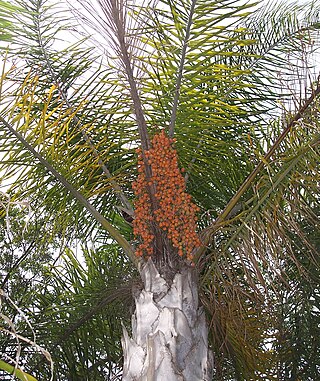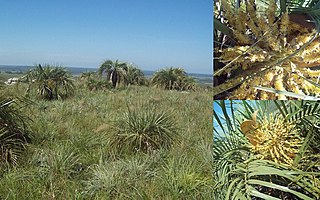
The Arecaceae is a family of perennial, flowering plants in the monocot order Arecales. Their growth form can be climbers, shrubs, tree-like and stemless plants, all commonly known as palms. Those having a tree-like form are called palm trees. Currently, 181 genera with around 2,600 species are known, most of which are restricted to tropical and subtropical climates. Most palms are distinguished by their large, compound, evergreen leaves, known as fronds, arranged at the top of an unbranched stem, except for the Hyphaene genus, who has branched palms. However, palms exhibit an enormous diversity in physical characteristics and inhabit nearly every type of habitat within their range, from rainforests to deserts.

Zamia furfuracea is a cycad endemic to southeastern Veracruz state in eastern Mexico.

Syagrus is a genus of Arecaceae (palms), native to South America, with one species endemic to the Lesser Antilles. The genus is closely related to the Cocos, or coconut genus, and many Syagrus species produce edible seeds similar to the coconut.

Butia is a genus of palms in the family Arecaceae, native to the South American countries of Brazil, Paraguay, Uruguay and Argentina. Many species produce edible fruits, which are sometimes used to make alcoholic beverages and other foods. The name is derived from a Brazilian vernacular word for members of the genus.

Butia eriospatha is a small species of Butia palm endemic to the highlands of southern Brazil. It is very similar to B. odorata, but is easily distinguished from this species by the distinct spathes which are densely covered in rust-coloured, woolly hairs. Indeed, the specific epithet is derived from Greek ἔριον, wool, and Latin spatha, which refers to the spathe. It has been given the name woolly jelly palm (UK) or wooly jelly palm (US) in English. Vernacular names for it where it is native are butiá-da-serra, butiázeiro, butiá-veludo, butiábutiá verdadeiro, butiá-do-campo, yatáy and macumá.

Butia purpurascens is a smallish, relatively slender, endangered species of Butia palm, up to 3-7m tall. It is locally known as palmeira-jataí, coqueiro-de-vassoura, butiá or coquinho-azedo in Portuguese. The Kalunga people call this palm cabeçudo.
Syagrus macrocarpa is a rare species of palm found only as scattered isolated individuals and small groups in the east of the Brazilian states of Espírito Santo, Minas Gerais and Rio de Janeiro. It grows to 4-10m tall, with 8-20 leaves to 2m long. The leaves are bent at the end, with very hairy margins near the trunk, and consist of 180-320 slightly coiled leaflets irregularly arranged in several planes on the rake. The fruit are oval, greenish-yellow, 6–9 cm long. It is grown in cultivation. Seeds are difficult to germinate, with low rates of germination. Common names for it in Minas Gerais are baba-de-boi-grande and maria-rosa.

Butia paraguayensis is a species of Butia palm tree found in the cerrado region of South America. Its natural range runs from Mato Grosso do Sul and São Paulo in southern Brazil through Paraguay to northern Argentina and Uruguay. It was given the name dwarf yatay palm in English by 2000, and it is locally known as yata'i in Guaraní in Paraguay, or butiá-do-cerrado in Portuguese in Rio Grande do Sul, Brazil.

Butia yatay, the jelly palm or yatay palm, is a Butia palm native to southern Brazil, Uruguay and northern Argentina. It is known as the butiá-jataí in Portuguese in the south of Brazil, as well as simply jataí or butiá. It is sometimes cultivated as an ornamental in Europe and the United States. It is the tallest of all the species in the genus Butia. The fruit is edible with a sweet flavour.

Trachycarpeae is a tribe of palms in subfamily Coryphoideae of the plant family Arecaceae. It has the widest distribution of any tribe in Coryphoideae and is found on all continents, though the greatest concentration of species is in Southeast Asia. Trachycarpeae includes palms from both tropical and subtropical zones; the northernmost naturally-occurring palm is a member of this tribe. Several genera can be found in cultivation in temperate areas, for example species of Trachycarpus, Chamaerops, Rhapidophyllum and Washingtonia.

Butia campicola is a very small species of Butia palm with an underground trunk; native to the cerrados of central Paraguay and south-central Brazil.

Butia odorata, also known as the South American jelly palm, jelly palm, or pindo palm, is a Butia palm native to southernmost Brazil and Uruguay. This slow-growing palm grows up to 10m, although it is often less tall. It is identifiable by its feather palm pinnate leaves that arch inwards towards a thick stout trunk.

Butia stolonifera was an oddly growing palm assigned to the genus Butia found only once in Uruguay in the 19th century, but which now is considered to be uncertain as a valid species.
Butia microspadix is a very small species of grass-like Butia palm usually with an underground trunk; native to the states of Paraná and São Paulo in Brazil.

Butia archeri is a small species of Butia palm with a short trunk native to the states of Goiás, Brasília, Minas Gerais and São Paulo in Brazil.
Butia arenicola is a very small species of Butia palm with an underground trunk; native to Paraguay and the state of Mato Grosso do Sul in Brazil. Boquierinho is recorded as a possible local vernacular name for it.
Butia matogrossensis is a smallish species of Butia palm with a trunk of only 0.5 m (20 in) in height or often subterranean, native to the cerrados of the centre, central-east, northeast and likely north of the state of Mato Grosso do Sul, after which it is named, in south-central Brazil. It also occurs in neighbouring south-central Goiás to the north. It is endemic to Brazil, occurring only in this country.
Butia pubispatha is a very small and extremely rare species of Butia palm with an underground trunk; endemic to the east of the state of Paraná in southeastern Brazil.
Butia catarinensis is a mid-sized species of Butia palm native to the states of Rio Grande do Sul, Santa Catarina in Brazil.













